Network Management Assignment - Network Security and Protocols
VerifiedAdded on 2020/04/15
|5
|1121
|33
Homework Assignment
AI Summary
This assignment provides a comprehensive analysis of network management concepts. It addresses network utilization, explaining the expected percentages for Ethernet and WAN connections. It also examines average frame sizes and justifies them based on communication types. The assignment delves into various network attack methods, including phishing, Trojan horses, and IP spoofing. It then explores ICMP protocol and its role in network security, including filtering techniques. Furthermore, it outlines the steps for adding a VPN to a network and addressing incoming connections. The assignment also covers FERPA regulations regarding student data privacy and defines the differences between Service Level Agreements (SLAs) and Memoranda of Understanding (MOUs). Finally, it highlights the importance of SLAs in maintaining service quality and providing customer assurance. The assignment references several key academic sources to support its claims.
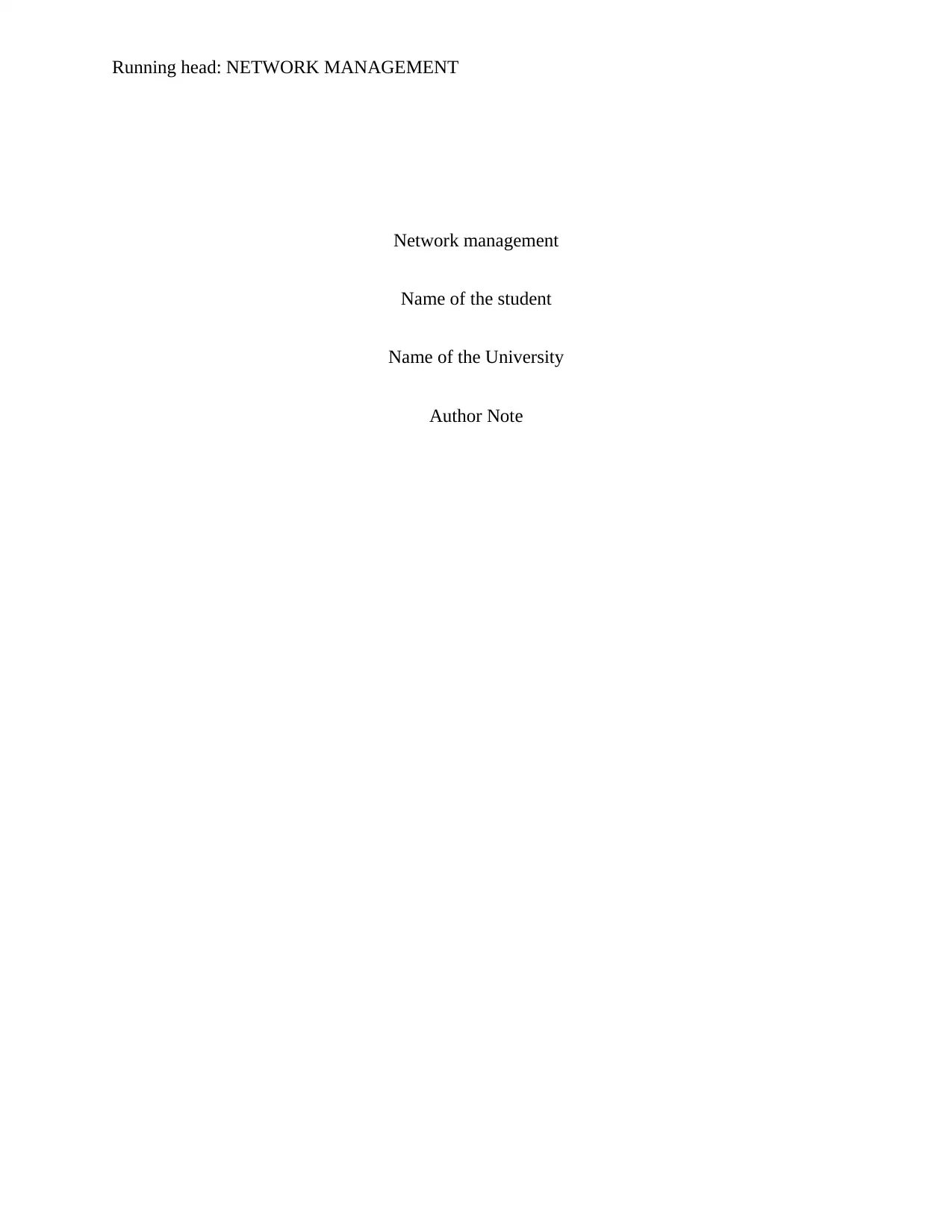
Running head: NETWORK MANAGEMENT
Network management
Name of the student
Name of the University
Author Note
Network management
Name of the student
Name of the University
Author Note
Paraphrase This Document
Need a fresh take? Get an instant paraphrase of this document with our AI Paraphraser
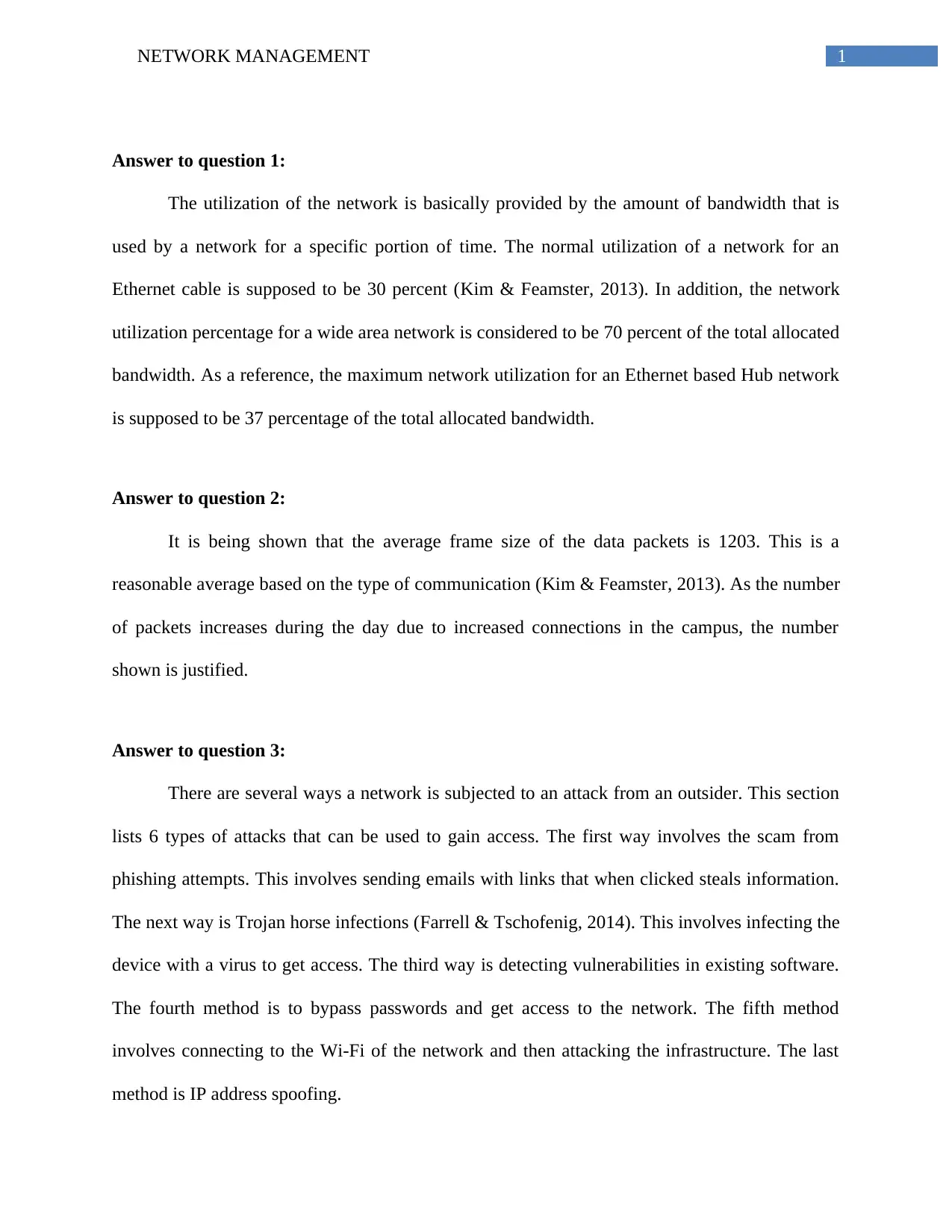
1NETWORK MANAGEMENT
Answer to question 1:
The utilization of the network is basically provided by the amount of bandwidth that is
used by a network for a specific portion of time. The normal utilization of a network for an
Ethernet cable is supposed to be 30 percent (Kim & Feamster, 2013). In addition, the network
utilization percentage for a wide area network is considered to be 70 percent of the total allocated
bandwidth. As a reference, the maximum network utilization for an Ethernet based Hub network
is supposed to be 37 percentage of the total allocated bandwidth.
Answer to question 2:
It is being shown that the average frame size of the data packets is 1203. This is a
reasonable average based on the type of communication (Kim & Feamster, 2013). As the number
of packets increases during the day due to increased connections in the campus, the number
shown is justified.
Answer to question 3:
There are several ways a network is subjected to an attack from an outsider. This section
lists 6 types of attacks that can be used to gain access. The first way involves the scam from
phishing attempts. This involves sending emails with links that when clicked steals information.
The next way is Trojan horse infections (Farrell & Tschofenig, 2014). This involves infecting the
device with a virus to get access. The third way is detecting vulnerabilities in existing software.
The fourth method is to bypass passwords and get access to the network. The fifth method
involves connecting to the Wi-Fi of the network and then attacking the infrastructure. The last
method is IP address spoofing.
Answer to question 1:
The utilization of the network is basically provided by the amount of bandwidth that is
used by a network for a specific portion of time. The normal utilization of a network for an
Ethernet cable is supposed to be 30 percent (Kim & Feamster, 2013). In addition, the network
utilization percentage for a wide area network is considered to be 70 percent of the total allocated
bandwidth. As a reference, the maximum network utilization for an Ethernet based Hub network
is supposed to be 37 percentage of the total allocated bandwidth.
Answer to question 2:
It is being shown that the average frame size of the data packets is 1203. This is a
reasonable average based on the type of communication (Kim & Feamster, 2013). As the number
of packets increases during the day due to increased connections in the campus, the number
shown is justified.
Answer to question 3:
There are several ways a network is subjected to an attack from an outsider. This section
lists 6 types of attacks that can be used to gain access. The first way involves the scam from
phishing attempts. This involves sending emails with links that when clicked steals information.
The next way is Trojan horse infections (Farrell & Tschofenig, 2014). This involves infecting the
device with a virus to get access. The third way is detecting vulnerabilities in existing software.
The fourth method is to bypass passwords and get access to the network. The fifth method
involves connecting to the Wi-Fi of the network and then attacking the infrastructure. The last
method is IP address spoofing.
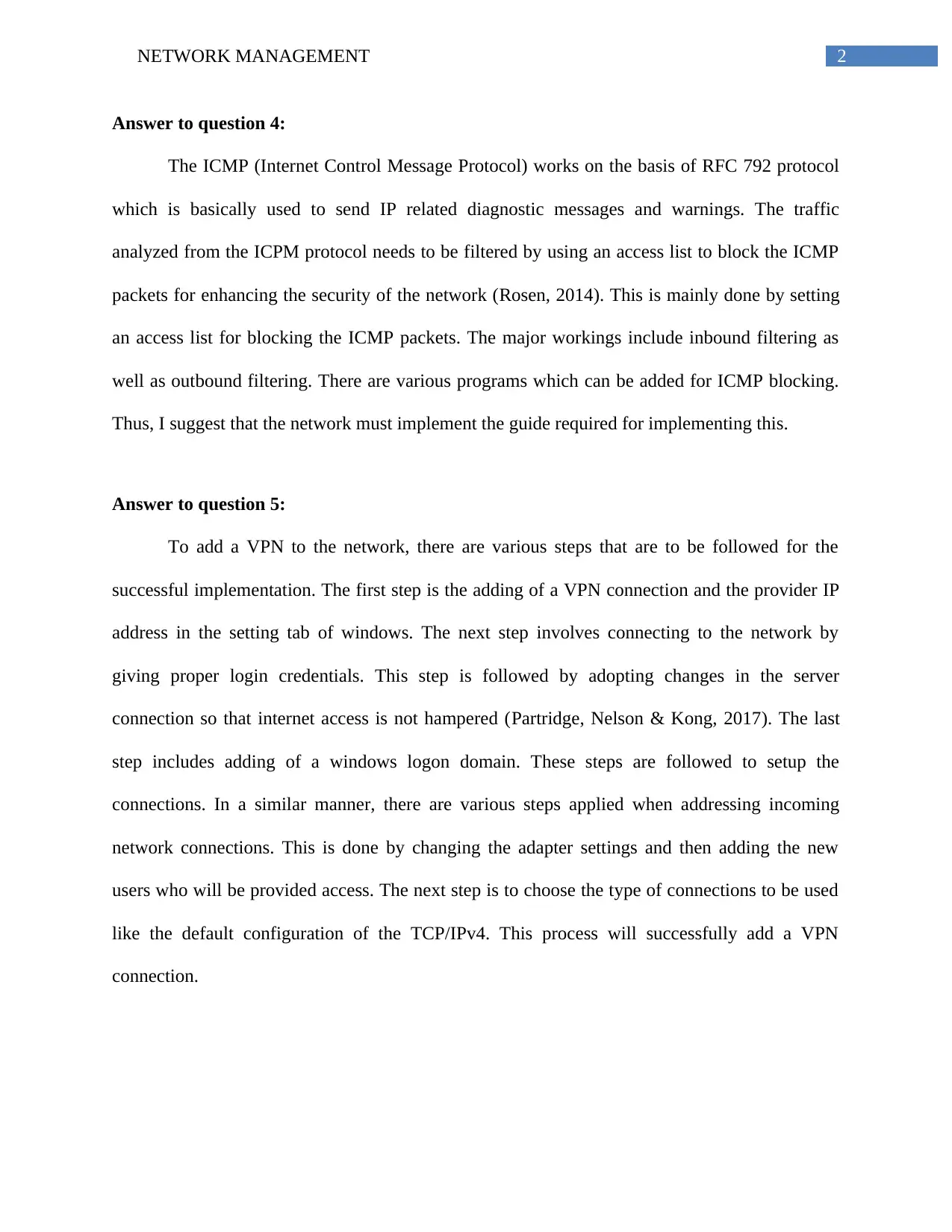
2NETWORK MANAGEMENT
Answer to question 4:
The ICMP (Internet Control Message Protocol) works on the basis of RFC 792 protocol
which is basically used to send IP related diagnostic messages and warnings. The traffic
analyzed from the ICPM protocol needs to be filtered by using an access list to block the ICMP
packets for enhancing the security of the network (Rosen, 2014). This is mainly done by setting
an access list for blocking the ICMP packets. The major workings include inbound filtering as
well as outbound filtering. There are various programs which can be added for ICMP blocking.
Thus, I suggest that the network must implement the guide required for implementing this.
Answer to question 5:
To add a VPN to the network, there are various steps that are to be followed for the
successful implementation. The first step is the adding of a VPN connection and the provider IP
address in the setting tab of windows. The next step involves connecting to the network by
giving proper login credentials. This step is followed by adopting changes in the server
connection so that internet access is not hampered (Partridge, Nelson & Kong, 2017). The last
step includes adding of a windows logon domain. These steps are followed to setup the
connections. In a similar manner, there are various steps applied when addressing incoming
network connections. This is done by changing the adapter settings and then adding the new
users who will be provided access. The next step is to choose the type of connections to be used
like the default configuration of the TCP/IPv4. This process will successfully add a VPN
connection.
Answer to question 4:
The ICMP (Internet Control Message Protocol) works on the basis of RFC 792 protocol
which is basically used to send IP related diagnostic messages and warnings. The traffic
analyzed from the ICPM protocol needs to be filtered by using an access list to block the ICMP
packets for enhancing the security of the network (Rosen, 2014). This is mainly done by setting
an access list for blocking the ICMP packets. The major workings include inbound filtering as
well as outbound filtering. There are various programs which can be added for ICMP blocking.
Thus, I suggest that the network must implement the guide required for implementing this.
Answer to question 5:
To add a VPN to the network, there are various steps that are to be followed for the
successful implementation. The first step is the adding of a VPN connection and the provider IP
address in the setting tab of windows. The next step involves connecting to the network by
giving proper login credentials. This step is followed by adopting changes in the server
connection so that internet access is not hampered (Partridge, Nelson & Kong, 2017). The last
step includes adding of a windows logon domain. These steps are followed to setup the
connections. In a similar manner, there are various steps applied when addressing incoming
network connections. This is done by changing the adapter settings and then adding the new
users who will be provided access. The next step is to choose the type of connections to be used
like the default configuration of the TCP/IPv4. This process will successfully add a VPN
connection.
⊘ This is a preview!⊘
Do you want full access?
Subscribe today to unlock all pages.

Trusted by 1+ million students worldwide
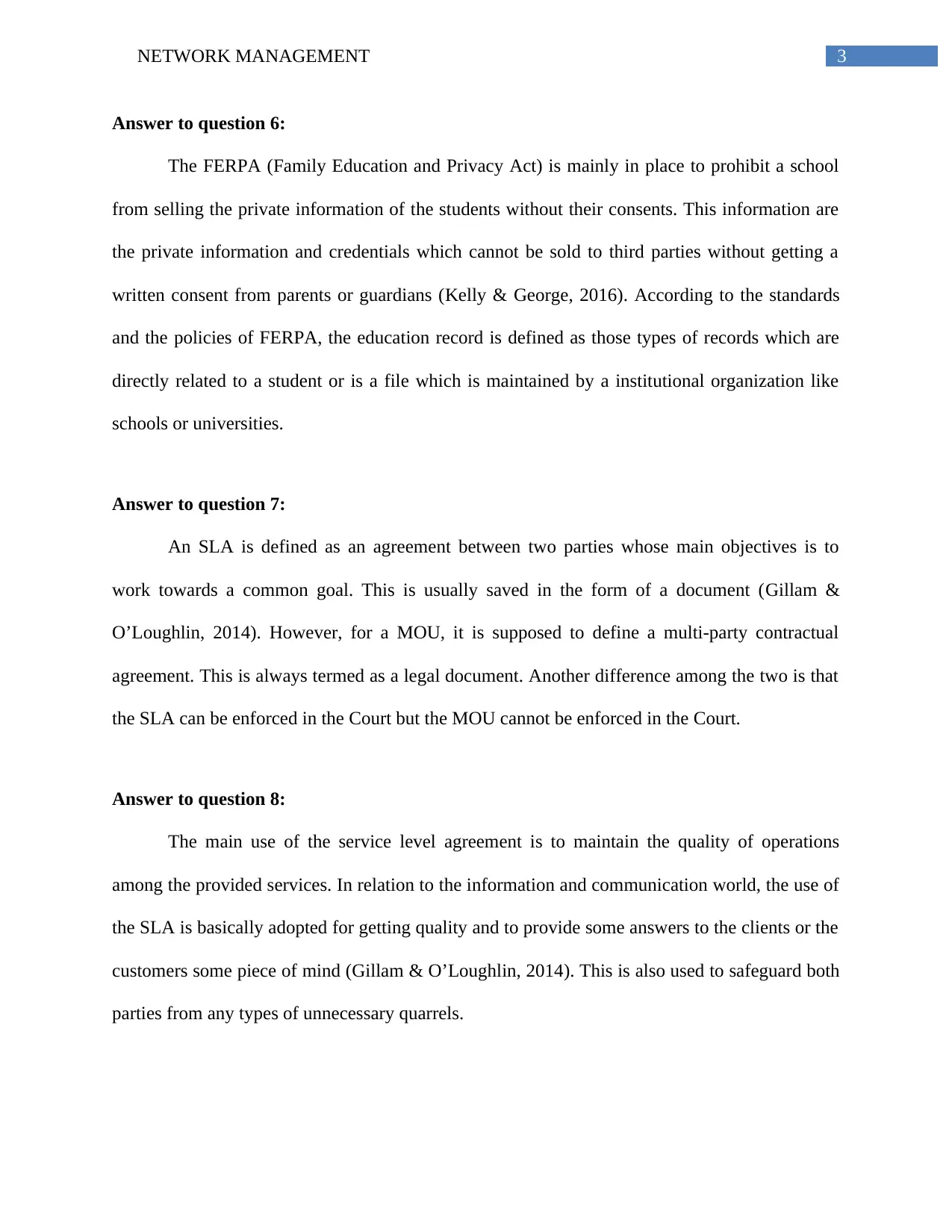
3NETWORK MANAGEMENT
Answer to question 6:
The FERPA (Family Education and Privacy Act) is mainly in place to prohibit a school
from selling the private information of the students without their consents. This information are
the private information and credentials which cannot be sold to third parties without getting a
written consent from parents or guardians (Kelly & George, 2016). According to the standards
and the policies of FERPA, the education record is defined as those types of records which are
directly related to a student or is a file which is maintained by a institutional organization like
schools or universities.
Answer to question 7:
An SLA is defined as an agreement between two parties whose main objectives is to
work towards a common goal. This is usually saved in the form of a document (Gillam &
O’Loughlin, 2014). However, for a MOU, it is supposed to define a multi-party contractual
agreement. This is always termed as a legal document. Another difference among the two is that
the SLA can be enforced in the Court but the MOU cannot be enforced in the Court.
Answer to question 8:
The main use of the service level agreement is to maintain the quality of operations
among the provided services. In relation to the information and communication world, the use of
the SLA is basically adopted for getting quality and to provide some answers to the clients or the
customers some piece of mind (Gillam & O’Loughlin, 2014). This is also used to safeguard both
parties from any types of unnecessary quarrels.
Answer to question 6:
The FERPA (Family Education and Privacy Act) is mainly in place to prohibit a school
from selling the private information of the students without their consents. This information are
the private information and credentials which cannot be sold to third parties without getting a
written consent from parents or guardians (Kelly & George, 2016). According to the standards
and the policies of FERPA, the education record is defined as those types of records which are
directly related to a student or is a file which is maintained by a institutional organization like
schools or universities.
Answer to question 7:
An SLA is defined as an agreement between two parties whose main objectives is to
work towards a common goal. This is usually saved in the form of a document (Gillam &
O’Loughlin, 2014). However, for a MOU, it is supposed to define a multi-party contractual
agreement. This is always termed as a legal document. Another difference among the two is that
the SLA can be enforced in the Court but the MOU cannot be enforced in the Court.
Answer to question 8:
The main use of the service level agreement is to maintain the quality of operations
among the provided services. In relation to the information and communication world, the use of
the SLA is basically adopted for getting quality and to provide some answers to the clients or the
customers some piece of mind (Gillam & O’Loughlin, 2014). This is also used to safeguard both
parties from any types of unnecessary quarrels.
Paraphrase This Document
Need a fresh take? Get an instant paraphrase of this document with our AI Paraphraser
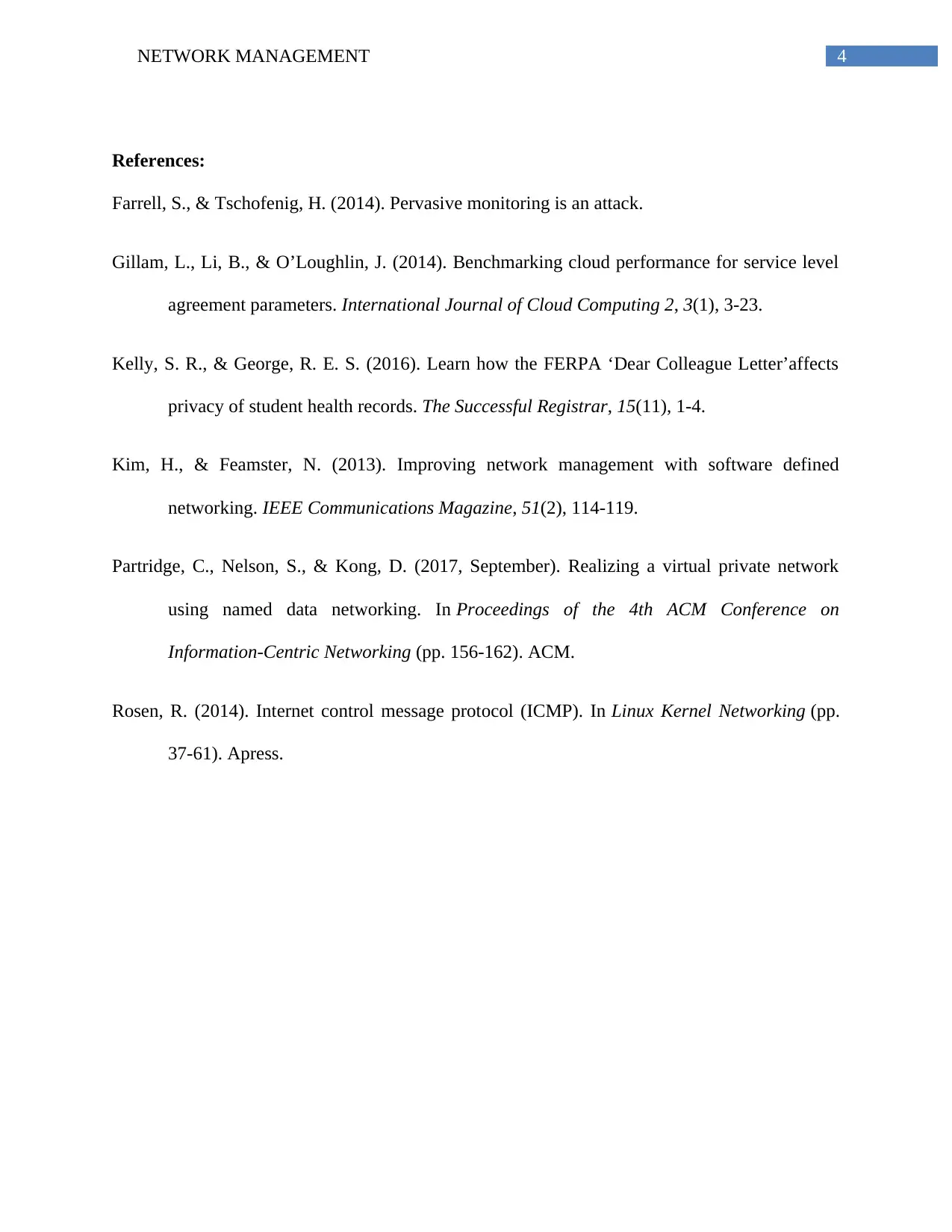
4NETWORK MANAGEMENT
References:
Farrell, S., & Tschofenig, H. (2014). Pervasive monitoring is an attack.
Gillam, L., Li, B., & O’Loughlin, J. (2014). Benchmarking cloud performance for service level
agreement parameters. International Journal of Cloud Computing 2, 3(1), 3-23.
Kelly, S. R., & George, R. E. S. (2016). Learn how the FERPA ‘Dear Colleague Letter’affects
privacy of student health records. The Successful Registrar, 15(11), 1-4.
Kim, H., & Feamster, N. (2013). Improving network management with software defined
networking. IEEE Communications Magazine, 51(2), 114-119.
Partridge, C., Nelson, S., & Kong, D. (2017, September). Realizing a virtual private network
using named data networking. In Proceedings of the 4th ACM Conference on
Information-Centric Networking (pp. 156-162). ACM.
Rosen, R. (2014). Internet control message protocol (ICMP). In Linux Kernel Networking (pp.
37-61). Apress.
References:
Farrell, S., & Tschofenig, H. (2014). Pervasive monitoring is an attack.
Gillam, L., Li, B., & O’Loughlin, J. (2014). Benchmarking cloud performance for service level
agreement parameters. International Journal of Cloud Computing 2, 3(1), 3-23.
Kelly, S. R., & George, R. E. S. (2016). Learn how the FERPA ‘Dear Colleague Letter’affects
privacy of student health records. The Successful Registrar, 15(11), 1-4.
Kim, H., & Feamster, N. (2013). Improving network management with software defined
networking. IEEE Communications Magazine, 51(2), 114-119.
Partridge, C., Nelson, S., & Kong, D. (2017, September). Realizing a virtual private network
using named data networking. In Proceedings of the 4th ACM Conference on
Information-Centric Networking (pp. 156-162). ACM.
Rosen, R. (2014). Internet control message protocol (ICMP). In Linux Kernel Networking (pp.
37-61). Apress.
1 out of 5
Related Documents
Your All-in-One AI-Powered Toolkit for Academic Success.
+13062052269
info@desklib.com
Available 24*7 on WhatsApp / Email
![[object Object]](/_next/static/media/star-bottom.7253800d.svg)
Unlock your academic potential
Copyright © 2020–2025 A2Z Services. All Rights Reserved. Developed and managed by ZUCOL.




